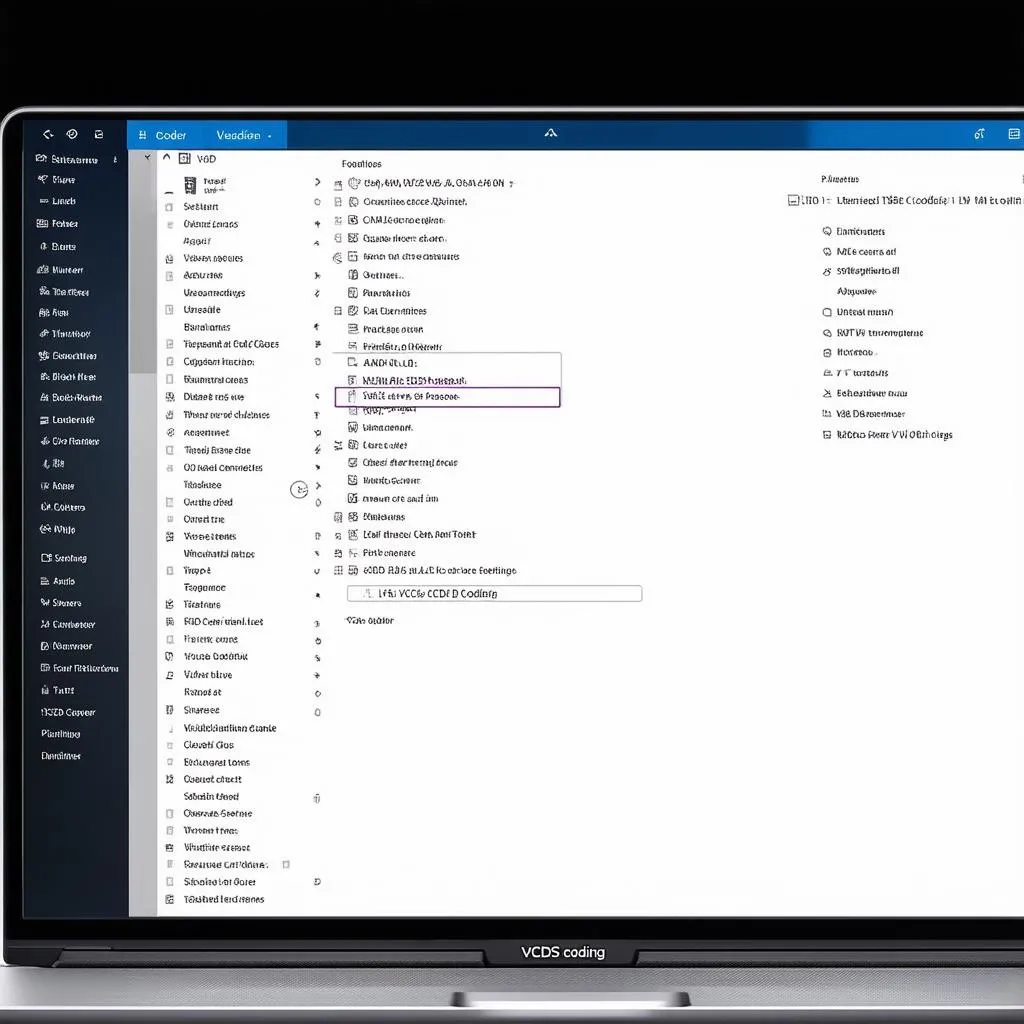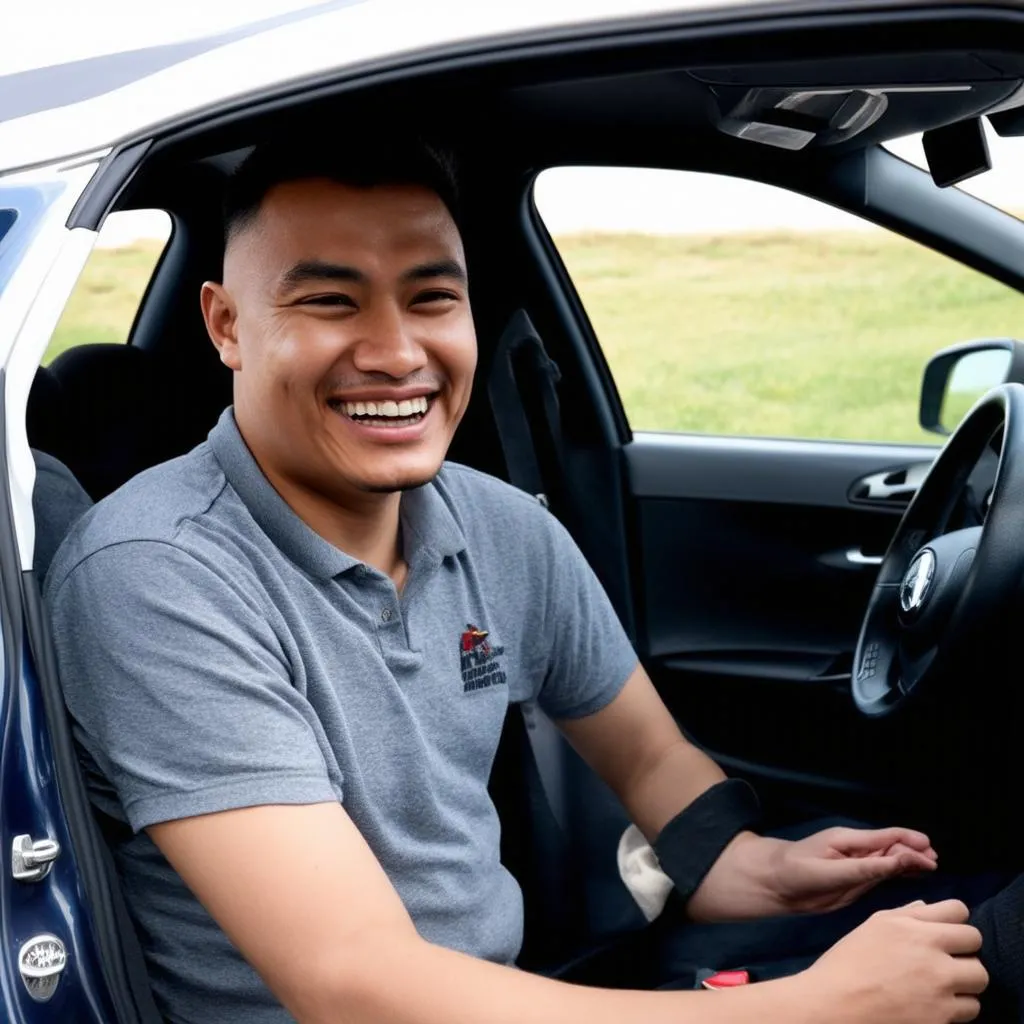VCDS Long Coding: A Comprehensive Guide to Unleashing Your Car’s Full Potential
Have you ever wished your car could do just a little bit more? Maybe you’ve wanted to customize features, fix annoying quirks, or even unlock hidden abilities. Well, you’re not alone! Many car enthusiasts are discovering the power of Vcds Long Coding, a process that allows you to reprogram your car’s control modules for a more personalized driving experience.
But what exactly is VCDS long coding? And how can it benefit you? Let’s dive into the fascinating world of VCDS long coding and unlock the secrets of your car’s hidden potential!
What is VCDS Long Coding?
Imagine your car’s control modules as a complex symphony of interconnected parts, each with its own unique tune. VCDS long coding is like the conductor’s baton, allowing you to adjust the volume, tempo, and even the instruments playing in this intricate symphony.
In simpler terms, VCDS long coding involves using a specialized diagnostic tool (like the VCDS software) to modify the coding within your car’s control modules. These modules are responsible for controlling everything from your headlights and wipers to your engine performance and climate control.
Think of VCDS long coding as unlocking a secret language that allows you to communicate directly with your car. It’s a powerful tool that can be used to fine-tune your car’s performance, enhance its features, and even troubleshoot problems that may not be apparent in conventional diagnostics.
The Benefits of VCDS Long Coding: A Symphony of Customization
The beauty of VCDS long coding is its versatility. It allows you to personalize your car in ways you never thought possible, from adding custom features to improving fuel efficiency. Here are some of the most common benefits:
1. Customize Features: Tailoring Your Car to Your Tastes
Ever wished your headlights would automatically switch to the high beam when no oncoming traffic is detected? Or maybe you’d like to enable the automatic door lock feature when you shift into drive? VCDS long coding can make these wishes a reality.
You can also tweak features like:
- Taillight behavior: Customize the sequence of your taillights, from simple flashes to more dynamic patterns.
- Window behavior: Change how your windows roll up and down, such as adding a one-touch feature or adjusting their speed.
- Climate control: Fine-tune your climate control system for optimal comfort, including things like temperature, fan speed, and seat heating/cooling.
- Instrument cluster: Adjust the display settings, add new gauges, or even enable hidden features like a digital speedometer.
Think of it as adding your own personal signature to your car’s symphony, creating a unique driving experience that reflects your individual preferences.
2. Enhance Performance: Unleashing the Power Within
VCDS long coding can go beyond just aesthetics. It can also fine-tune your car’s performance, making it more efficient, responsive, and exhilarating to drive. Here’s how:
- Engine management: Optimize your engine’s performance by adjusting parameters like ignition timing, fuel mixture, and throttle response. This can lead to improved fuel economy, increased power, and smoother acceleration.
- Transmission tuning: Enhance your transmission’s shift points and responsiveness, resulting in smoother and more efficient gear changes.
- Suspension calibration: Adjust your suspension settings for a more comfortable ride, better handling, or a sportier feel.
By fine-tuning these parameters, you can create a symphony of performance that truly sings.
3. Troubleshooting and Problem Solving: Solving the Riddle of Your Car’s Symphony
Sometimes, your car’s symphony can become disharmonious. You might encounter strange noises, erratic behavior, or even malfunctioning features.
VCDS long coding can be a powerful tool for troubleshooting these problems. It allows you to delve into the control modules and identify potential issues, providing insights that traditional diagnostics may miss.
Imagine you’re a detective investigating a mysterious case. VCDS long coding gives you the tools to examine clues, analyze data, and pinpoint the root cause of the problem.
VCDS Long Coding: A Guide to the Symphony of Your Car
Now that you understand the benefits of VCDS long coding, let’s dive into the practical aspects of how it works.
1. The VCDS Tool: The Conductor’s Baton
The first step is to obtain a VCDS (Vehicle Communications Diagnostic System) tool. VCDS is a powerful software and hardware package designed for coding and diagnostics on Volkswagen, Audi, Seat, and Skoda vehicles.
Think of the VCDS tool as the conductor’s baton, allowing you to direct the symphony of your car’s control modules. It provides a user-friendly interface for navigating the complex coding within your car’s systems.
2. Understanding Long Coding: Deciphering the Language of Your Car
Long coding is a specific type of coding within your car’s control modules. It consists of a series of binary digits (0s and 1s) that represent different settings and features.
Each digit within the long coding string corresponds to a specific parameter or function. For example, one digit might control the behavior of your taillights, while another digit might control your door locks.
You can access these long coding values through the VCDS software. By modifying these values, you can change the way your car operates.
Think of long coding as a complex language of your car, where each digit represents a word in a sentence. The VCDS software acts as your translator, allowing you to understand and modify this language.
3. Long Coding Changes: A Symphony of Customization
VCDS long coding offers a wide range of customization options for various car functions.
Here are some examples of common long coding changes:
- Enabling or disabling features: You can turn features on or off, such as automatic door locks, rear fog lights, or the DRL (Daytime Running Lights).
- Adjusting behavior: You can change the behavior of certain features, such as the speed of your windows, the sensitivity of your headlights, or the duration of your turn signals.
- Tailoring settings: You can adjust specific settings to your preferences, like the brightness of your instrument cluster, the default temperature for your climate control, or the behavior of your cruise control.
Each change you make with VCDS long coding is a note in the symphony of your car’s customization.
 vcds-long-coding-example
vcds-long-coding-example
Navigating the World of Long Coding: Tips and Best Practices
VCDS long coding is a powerful tool, but it’s important to use it responsibly and with caution. Here are some tips and best practices to keep in mind:
- Do your research: Before making any changes, carefully research the specific coding values and their effects on your car.
- Back up your existing coding: Always back up your existing long coding values before making any changes. This allows you to restore your car to its original state if something goes wrong.
- Start with small changes: When you’re first learning about VCDS long coding, start with small, simple changes. This will help you understand the process and avoid any unintended consequences.
- Seek expert advice: If you’re unsure about something, don’t hesitate to seek advice from a qualified technician or a reputable online forum.
- Avoid unnecessary changes: Only make changes that you understand and that you believe will improve your car’s performance or features.
Remember, VCDS long coding is a powerful tool, but like any tool, it requires respect and careful handling. Use it wisely and enjoy the benefits of a truly customized driving experience.
Frequently Asked Questions About VCDS Long Coding
Now let’s address some common questions that car enthusiasts have about VCDS long coding.
1. Is VCDS long coding safe?
With careful research and practice, VCDS long coding can be a safe and effective way to customize your car. However, as with any modification, there is always a risk of unintended consequences if done incorrectly.
Following the tips and best practices outlined above will help to minimize these risks.
2. Can I do VCDS long coding myself?
Yes, VCDS long coding is something you can do yourself. The VCDS software is relatively user-friendly, and there are many online resources available to help you get started.
However, it’s important to remember that VCDS long coding requires a certain level of technical expertise. If you’re not comfortable with automotive electronics, it’s best to seek help from a qualified technician.
3. Is VCDS long coding legal?
In most cases, VCDS long coding is legal. However, it’s important to be aware of any local laws or regulations that may apply. For example, some jurisdictions may restrict modifications that affect safety features, such as airbags or ABS.
Always consult with your local authorities to ensure you’re complying with all applicable laws.
4. What are some common VCDS long coding examples?
Here are some common examples of VCDS long coding changes that many car enthusiasts make:
- Enabling daytime running lights (DRL): You can enable the DRLs to increase visibility during daylight hours.
- Customizing the taillight sequence: You can create a custom sequence for your taillights, such as a dynamic flash or a sequential turn signal.
- Adjusting the window speed: You can adjust the speed at which your windows roll up and down.
- Enabling the one-touch window feature: You can enable a feature that allows you to roll your windows up or down with a single touch of the button.
- Disabling the seatbelt chime: You can disable the annoying chime that sounds when your seatbelt is unbuckled.
These are just a few examples of the many possibilities available with VCDS long coding.
5. What car models support VCDS long coding?
VCDS long coding is primarily designed for vehicles manufactured by Volkswagen, Audi, Seat, and Skoda. It supports a wide range of models, including the Golf, Passat, A4, Q5, and more.
The specific models and features supported by VCDS long coding may vary. You can check the VCDS website or consult with a qualified technician to confirm compatibility.
6. Can I use VCDS long coding to fix a broken part?
VCDS long coding cannot fix a broken part. It can be used to reprogram control modules, but it cannot physically repair damaged components.
If you have a broken part, it needs to be replaced or repaired by a qualified technician.
7. Is there any risk of voiding my car’s warranty?
Modifying your car’s software, even with VCDS long coding, could potentially void your car’s warranty. It’s important to check your car’s warranty documentation to understand the specific terms and conditions.
It’s always a good idea to consult with your car’s manufacturer or dealer before making any modifications that could affect your warranty.
Discover More About VCDS Long Coding: Explore Our Website
Want to learn more about VCDS long coding? Check out our other articles on our website:
- VCDS Long Coding Helper Download: Get the best VCDS long coding helper tool.
- VCDS Long Coding 2009 Audi A4 Quattro 2.0T: Learn how to unlock the full potential of your 2009 Audi A4 Quattro 2.0T.
- VCDS Long Coding Accepted But Not Saved: Troubleshoot this common VCDS long coding issue.
- VCDS Long Code Helper: Discover the best long code helpers available.
- VCDS 409.1 Long Coding: Learn about the specific features and possibilities of VCDS 409.1.
Ready to unlock the hidden symphony of your car? Contact us at +84767531508 on Whatsapp for expert guidance on VCDS long coding and other car diagnostics tools. Our team of automotive experts is available 24/7 to assist you.
Conclusion: Tune Your Car’s Symphony to Perfection
VCDS long coding is a powerful tool that allows you to personalize your car in ways you never thought possible. By understanding the basics of long coding and following the tips and best practices outlined above, you can safely and effectively customize your car’s features, enhance its performance, and troubleshoot problems.
So, what are you waiting for? Unleash the full potential of your car and let its symphony sing!
Don’t forget to share this article with your fellow car enthusiasts and leave a comment below with your thoughts on VCDS long coding. We’d love to hear your experiences and insights!
 vcds-long-coding-success
vcds-long-coding-success
